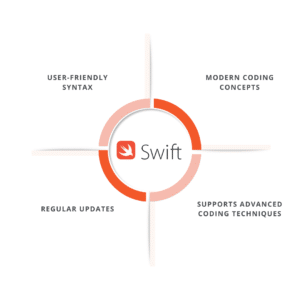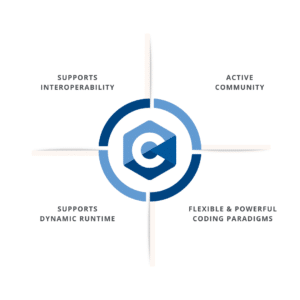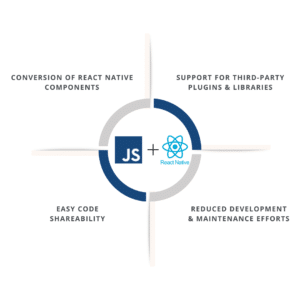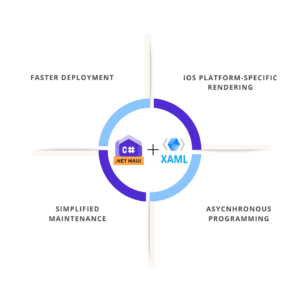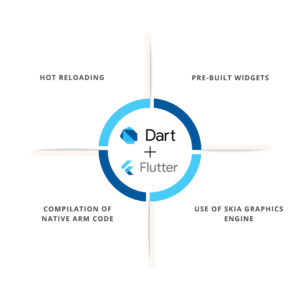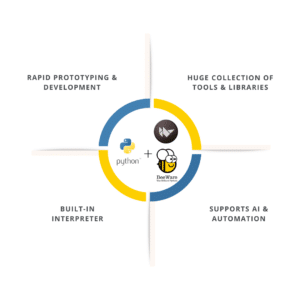As of today, iOS app development holds utmost relevance for businesses to stand out in the crowd of competitors. However, the demand for innovation and improved performance is continually increasing for iOS apps, which is why businesses strive to pick the right programming language to get started with their development project.
Choosing the best language for iOS app development ensures the end product showcases optimal performance, functionality, scalability, and user experience. In this article, you will get a clear insight into some of the top iOS programming languages that are commonly preferred for app development in 2025.
6 Best iOS App Development Programming Languages to Count On
Undoubtedly, there is a myriad of language options available when it comes to programming an iOS mobile app. However, here is the list of the top 6 languages that have the capability to integrate unique functionalities into your iOS app:
1. Swift
When talking about iOS app development, you cannot miss out on Swift, the primary and most powerful programming language for the purpose. Swift is developed by Apple itself to support development attributes for iOS, watchOS, tvOS, and macOS apps.
The ease-of-use and efficiency of Swift have made it the go-to language for iOS app developers. Beyond that, Swift also embeds high-end performance capabilities and safety features, making it a lucrative option for building your iOS app.
Key Features:
- User-friendly syntax, designed to be clear & expressive. Due to this, Swift becomes one of the most developer-friendly programming languages for iOS.
- Swift comes with modern coding concepts such as generics or closures, meant to enhance overall app development productivity and reduce the possibility of errors.
- With Apple’s strong commitment to Swift, this programming language receives regular updates with enhanced features. Due to this, your iOS app developers will gain access to the latest coding techniques.
2. Objective-C
With the rise of the Apple ecosystem, Objective-C has been a trusted foundational programming language for building efficient iOS and macOS apps. Even though newer coding languages such as Swift have become a primary preference, Objective-C holds its ground, being beneficial for maintaining older apps or working with legacy code.
It is one of those languages that is deeply integrated with the dynamic features and frameworks of Apple, making it powerful enough for dedicated user cases. Upon mastering the syntax of Objective-C, your iOS app developers will be able to use flexible and powerful coding paradigms, ensuring a high-performance end-product.
Key Features:
- Objective-C is compatible with Swift, allowing interoperability for developers. It means that the incorporation of existing Objective-C code into the new Swift projects can be made possible through a flexible transition.
- There’s an active community for Objective-C, backed by enough resources for troubleshooting and learning.
- Supports dynamic runtime, enabling developers to make coding decisions during the runtime, and not at compile time.
3. JavaScript
JavaScript, in combination with React Native, supports efficient cross-platform app development. React is a popular framework or library for developers to curate appealing and responsive user interfaces. This combination of programming language and an open-source framework allows developers to create apps that can natively render for iOS as well as Android, all using a single codebase.
When combined with React Native, JavaScript supports rapid deployment, quick prototyping, and easy code sharing. Beyond that, React Native and JavaScript can together support a hot reloading feature, enabling developers to monitor the functionality changes in real-time, without the need for recompilation. Thus, it becomes an ideal pick for iOS app development projects.
Key Features:
- Easy conversion of React Native components into platform-specific components, enabling a seamless user experience.
- Using JavaScript with React Native for iOS app development will extend support for diverse third-party libraries or plugins.
- Easy code shareability across both Android and iOS platforms, reducing the development and maintenance efforts of developers.
4. C# and XAML
C# and XAML (Extensible Application Markup Language) together form a potent combination for supporting iOS app development, backed by .NET MAUI as the cross-platform framework. It enables developers to seamlessly share a single codebase to make the app accessible across Windows, Android, and iOS platforms.
The .NET MAUI framework is the evolution of Xamarin. Forms, backed with improved UI controls, guarantee better extensibility and performance. Developers can leverage XAML for defining the UI layouts or controls in a declarative manner, following which the .NET MAUI framework will translate them into the native interface elements specific to iOS.
This combination of XAML and C# will provide developers with access to the native APIs and a vast UI component library. Rapid development, faster deployment, and easy maintenance are a few of the benefits you will avail out of by utilizing the .NET MAUI framework with C# and XAML.
Key Features:
- The .NET MAUI framework enables developers to build iOS, Windows, and Android apps using the C# and XAML languages. Due to this, you can attain faster deployment and simplified maintenance across all platforms.
- Expect native UI and platform-specific rendering, leading the development of high-performance iOS apps.
- C# is favorable for iOS app development, mostly for its exclusive features such as asynchronous programming, strong typing, and LINQ for query capabilities.
5. Dart
Dart, by Google, is a client-centric programming language introduced for building web, desktop, server, and mobile applications. This language is used within the Flutter framework, an open-source UI SDK, for building high-performance iOS apps. Dart has an easy syntax, posing a simple learning curve for developers who are already used to languages like JavaScript or Java.
The Flutter framework will enable your developers to create a single codebase using Dart as the programming language, making your app deployable across both Android and iOS platforms. When seeking iOS app development specifically, Flutter has the capability of compiling Dart code into the native ARM code. Thus, it results in the deployment of high-performance apps with a user experience similar to that of the native iOS applications. The modern language capabilities, when blended with an easy-to-use UI toolkit, you can create high-performance iOS apps at ease.
Key Features:
- The Hot Reload feature of Flutter is the epitome of this combination for iOS app development, enabling developers to monitor code changes in real-time.
- Dart, being the core iOS programming language in this combination, comes with a plethora of pre-built widgets built by adhering to Cupertino for iOS, ensuring your app gets an authentic look & feel.
- Flutter compiles the native ARM code with the use of Dart, enabling the app to run with top-notch performance on both iOS as well as Android OS.
- Flutter makes use of Skia Graphics Engine for curating smooth animations and faster renderings. It can help you achieve a native performance feel across all devices.
6. Python
When combined with cross-platform frameworks like BeeWare and Kivy, Python becomes one of the many preferred programming languages for iOS app development. Even though it is not a native iOS programming language, it is still a valuable solution in a developer’s toolbox because of its quick integration and prototyping capabilities with advanced technologies like AI.
Kivy, a cross-platform development framework, enables developers to build graphical UIs using Python code and deploy them for iOS apps. On the other hand, BeeWare is a vast set of libraries and tools, capable of building cross-platform applications with a native feel by using Python. This framework aims to translate the Python code into UI elements specific to iOS or Android.
Key Features:
- This combination supports rapid prototyping and development of iOS apps.
- Python comes with a huge collection of tools and libraries, especially in the field of automation and AI.
- This programming language comes with a built-in interpreter, enabling developers to directly run the codebase without the need for compilation.
Let Simpalm Ease Your Approach Towards Attaining the Best iOS App Development Solutions!
Every programming language serves a unique purpose and use case in iOS app development. At Simpalm, we will be assessing your requirements and expectations associated with your iOS app development project, and will align them with the right programming language.
We have a dedicated team of iOS app developers, proficient in using all the top languages and frameworks, alongside the updated development methodologies. Our aim is to make sure every line of code written for your application is meant to deliver exceptional performance and enhanced user experience.
Whether you need an iOS, macOS, watchOS, or tvOS app to expand your business outreach and productivity, we have the right tools, resources, and expertise to help you attain the best outcomes. From choosing the right iOS programming language to developing a productive app, we will be backing your app development project at all stages.
So, if you have an idea or vision to craft a mobile application and enroll your business into the Apple ecosystem, feel free to reach out to us and learn more about our iOS app development services.

 App Development
App Development Web Engineering
Web Engineering AI Services
AI Services Startups
Startups Health / Fitness
Health / Fitness Education
Education Social
Social Nonprofit
Nonprofit Fintech
Fintech Logistics
Logistics Government
Government HR Software
HR Software About Simpalm
About Simpalm Our News
Our News Client Testimonials
Client Testimonials Careers
Careers Awards
Awards Resources
Resources Information
Information
